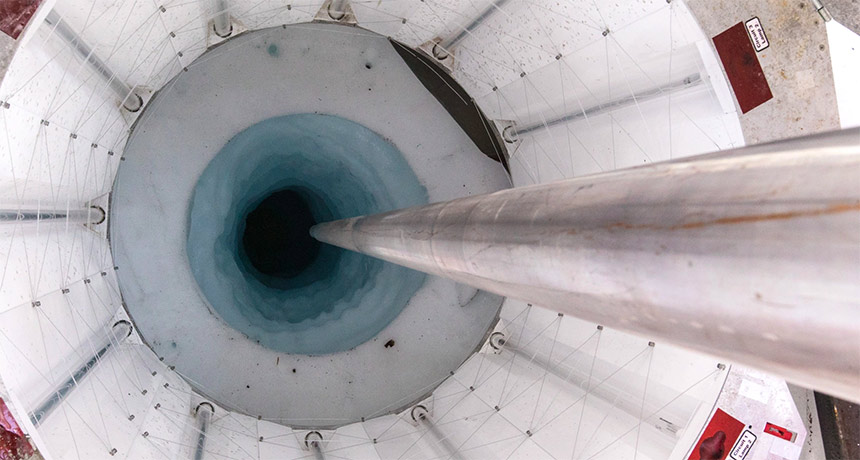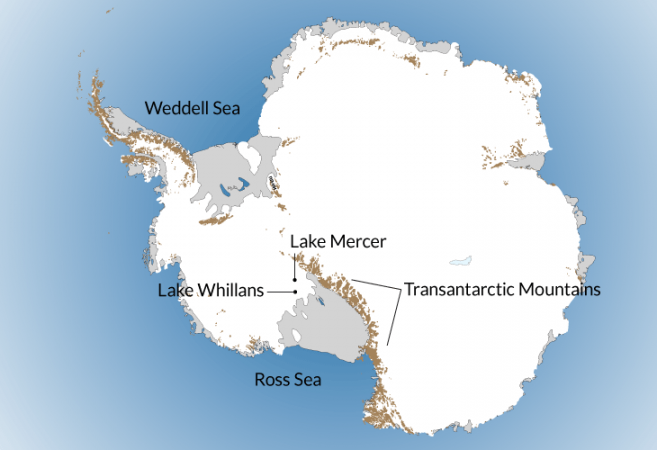Animal graveyard found in deeply buried Antarctic lake
Mud from Lake Mercer revealed tiny squashed creatures that resemble spiders and worms

Researchers drilled through a kilometer of ice above Lake Mercer in Antarctica. They found mud that contained carcasses of tiny animals resembling spiders, crustaceans, worms and water bears.
Billy Collins/SALSA Science Team
Scientists have uncovered a big surprise from Antarctica’s Lake Mercer: the remains of tiny animals. Some looked like “squished spiders and crustacean-type things with legs,” says David Harwood. “Some other things … looked like they could be worms.”
Harwood is a micropaleontologist. He studies fossils of microscopic creatures at the University of Nebraska–Lincoln. He was describing animal carcasses retrieved from Lake Mercer, some 600 kilometers (370 miles) from the South Pole.
A thick layer of ice has topped this lake for thousands of years. In late December, researchers drilled through about a kilometer (0.6 mile) of that ice to reach the lake. The mud they dredged up from its bottom contained the animal remains. They found the tiny carcasses by examining the water and mud under a microscope.
Harwood was part of an expedition known as SALSA, which stands for Subglacial Antarctic Lakes Scientific Access. Its researchers were the first to sample this deeply buried lake. In addition to the other animal carcasses, they spotted what appeared to be remnants of a water bear. Water bears, or tardigrades, are durable microscopic critters. Examining DNA from the remains will help researchers ID them.
An announcement of the SALSA team’s discovery of Lake Mercer’s animal graveyard appeared in a news report published online January 18 in Nature.
Were they lake dwellers or just drop-ins?
Until now, scientists hadn’t considered that Antarctic lakes like Mercer could host organisms larger than microbes. That’s why this find “is really intriguing,” says Slawek Tulaczyk. Not part of the SALSA team, he studies glaciers for the University of California, Santa Cruz.
In 2013, scientists sampled another buried lake in Antarctica — Lake Whillans. “We didn’t uncover any evidence of anything more complex than a microbe,” says SALSA team member Brent Christner. He is a microbiologist at the University of Florida in Gainesville. “We had a similar expectation” for Lake Mercer, he says.

It’s unclear if animals that once lived in Lake Mercer left behind the newly unearthed carcasses, Tulaczyk says. Ice or water may have carried these fragments in from the ocean. Or the remains could have washed in from nearby lakes in the Transantarctic Mountains.
The SALSA team could use radiocarbon dating to help pinpoint the samples’ ages. This technique works by comparing the relative amounts of two forms of carbon. One of them, carbon-14, is radioactive. That means it is unstable and sheds energy. As carbon-14 loses energy, it turns into carbon-12. This conversion occurs at a known rate. The ratio of carbon-12 to carbon-14 in material from a once-living object can be used to determine its age. And that, Tulaczyk says, may provide a clue as to how and when these minuscule carcasses arrived in Lake Mercer.
If any of these animals once called Lake Mercer home, some of them may still be alive down there, Harwood says. “It’s interesting to think that life can exist in really extreme environments,” he says. Lake Mercer is a great example.
The lake has been cut off from both the ocean and atmosphere for thousands of years. Indeed, Harwood says, “If life is still persisting there, that’s important for our thoughts about what we might find out in space.”







